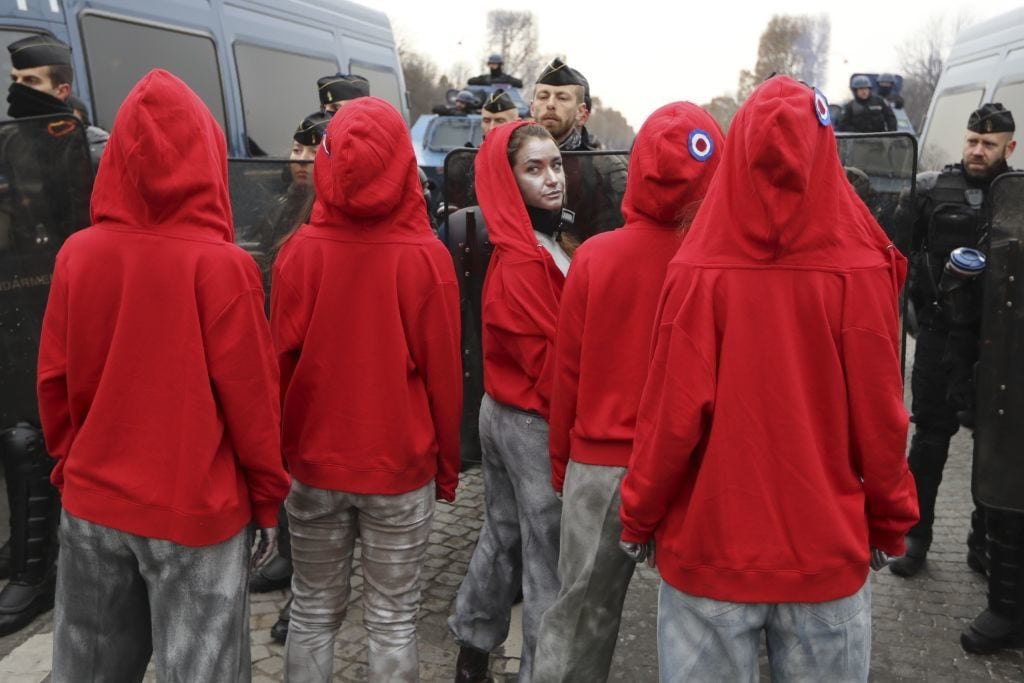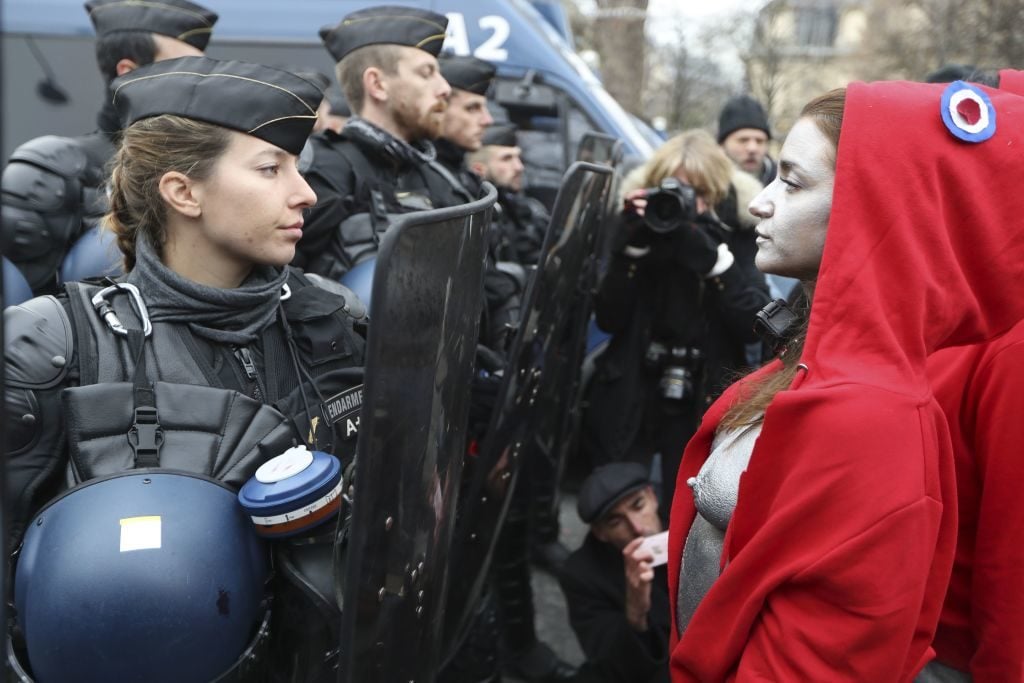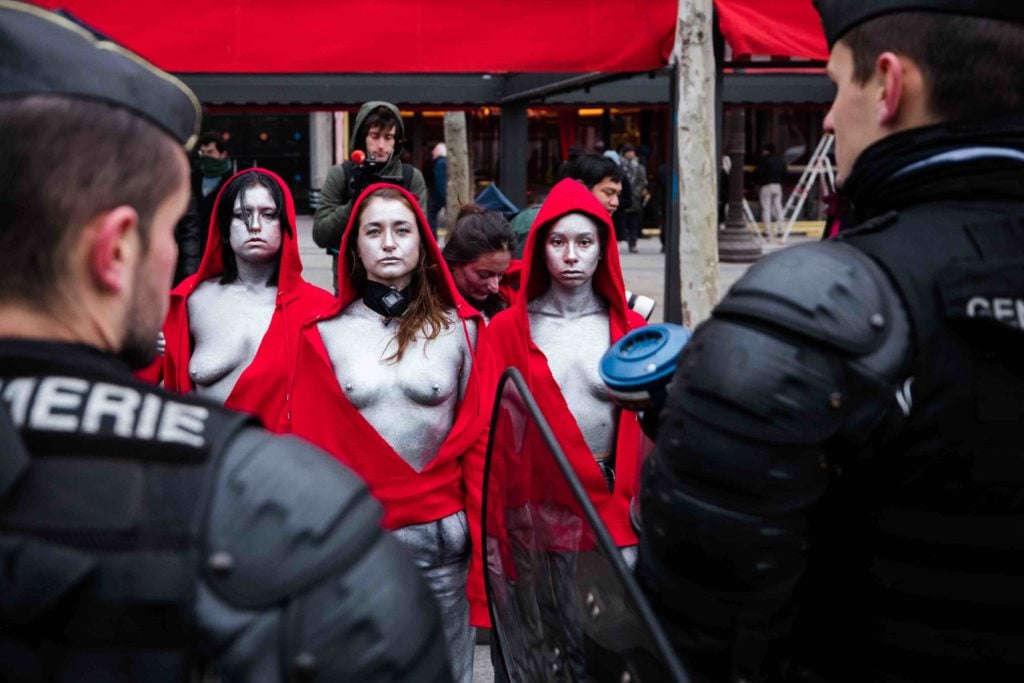Politics
Meet the Performance Artist Who Organized the Iconic Semi-Nude ‘Marianne’ Protest During France’s Yellow Vest Riots
Deborah De Robertis opens up about her happening during the yellow vest protests.

Deborah De Robertis opens up about her happening during the yellow vest protests.

Naomi Rea

Day-glo yellow vests are an indelible symbol of the “gilets jaunes” protests that have gripped France for the past month. But one enduring image from the populist uprising has no neon in sight. It is, instead, a defiant gathering of women in red hooded sweatshirts.
The tableau was staged by the feminist performance artist Deborah De Robertis, who joined the anti-tax protesters in Paris on the fifth consecutive weekend of demonstrations to lead a troupe of bare-breasted Mariannes—the female goddess of liberty and reason who has come to symbolize the French Republic—into the breach.
De Robertis has so far been silent about the intent of her performance, although the images have taken off online and even been co-opted by French law enforcement. Now, she opens up to artnet News about the conceptual feminist work, titled #Marianne is watching you.
Covered in silver body paint and clad in red-hooded sweatshirts adorned with tricolor cockades, the performers appeared as a small army of Mariannes, the same woman who adorns French euro coins, postage stamps, and town halls across the country. On Saturday, December 15, the artist led these five women—known as Gala, Aghata Kay, Andrea Macea, and L-CD—in a fierce, silent standoff with police for more than half an hour.
The goal, De Robertis says, was to disrupt the two-dimensional vision of Marianne and create a plurality of autonomous female subjects capable of looking back at power, not merely symbolizing it from on high. In this performance, “Marianne, dressed in a red hooded sweatshirt, climbs down from her pedestal and into the streets, freeing herself from the insignia of power and patriarchy,” De Robertis says.
The image of the red-hooded, bare-breasted army quickly began to spread, with many media outlets making the connection to the national icon and some incorrectly identifying it as an action of the activist feminist group FEMEN.
De Robertis says she sought to orchestrate a memorable picture that would mark the presence of women in this turbulent period of history. While the visibility of women in the yellow vest movement has somewhat been addressed in the media, the artist believes that this is not enough. “It is women who are first affected by precariousness, and they are often erased from history,” she says. “Today they become the initiators and actors of the revolution of the yellow vests, a revolt which is now extending all over the world.”
For her part, De Robertis is no stranger to public nudity. She is perhaps best known for revealing her vagina at museums including the Louvre and Musée d’Orsay to make a statement about women’s place in art history. Like her previous actions in front of Courbet’s The Origin of the World and the Mona Lisa, this work was a reenactment of another art historical treasure: Eugéne Delacroix’s depiction of a bare-breasted Marianne in the painting Liberty Leading the People. The female protagonist of the famous work could have been Marie Deschamps, a real working-class woman who took part in the July revolution of 1830—but who has since been “swallowed up in the allegorical frenzy of power,” according to De Robertis.
“This time,” De Robertis says, “history will not be made without us women.”

Deborah de Robertis facing off with a female French police officer. Photo by Valery Hache/AFP/Getty Images.
One particular image from the demonstration has already taken on a life of its own: An image of De Robertis locked in a standoff with the only female police officer in the group.
The image even caught the attention of French authorities, who De Robertis says have sought to reinterpret it for their own ends. The director of the French police force gifted the photograph to the depicted female policewoman in an official ceremony, which the artist alleges is their attempt to reframe her as their own Marianne.
To De Robertis, the face-off—and the subsequent reaction—illustrate an attempt to make Marianne in 2018 the armed protector of the state, not the people. “By trying to make this image an icon that goes in the direction of the current power, it tries to take over the hundreds of other photos that will forever leave the indelible trace of a conception of Marianne who is against the established order,” she says. “No, they will not blur the appearance of our bodies in the field of politics.”
Throughout history, she says, women have been forced into the dichotomy of “the virgin” and “the whore”—De Robertis references the theorist Laurette Massant in her artistc statement—and she sought to push against that oversimplified framework by seeking out the police officer. “Today, social networks… have already launched a new sexist contest,” she observes. “Who is the real Marianne? The ‘uniformed police officer’ or the ‘anarchist slut’?”

De Robertis and the Mariannes. © DR Photo by Jacob Khrist.
Across France, tens of thousands of people have mobilized over the past six weekends in a battle that began over a proposed hike in fuel tax but morphed into expressions of wider dissatisfaction about living conditions and the policies of French president Emmanuel Macron.
In recent days, the furor has somewhat calmed down after Marcon made emergency concessions to the protesters. On December 21, the French National Assembly approved tax cuts for low-income workers estimated to cost the state around €15 billion ($17 billion). But it remains unclear what effect the protests will have on the future of French politics.
Meanwhile, anti-establishment movements inspired by the protesters (and their high-visibility yellow vests) have since spread worldwide, with “yellow vest” demonstrators surfacing in Brussels, Germany, Greece, and Portugal as well as countries as far-flung as Taiwan, Canada, and Iraq.
See a video below documenting De Robertis’s happening produced by the artist with the videographer Alexandre Carril, with thanks to Oksana Shalyngina, Iryna Sobchenko, and Gala for their active support.
#MARIANNEISWATCHINGYOU from Deborah De Robertis official on Vimeo.